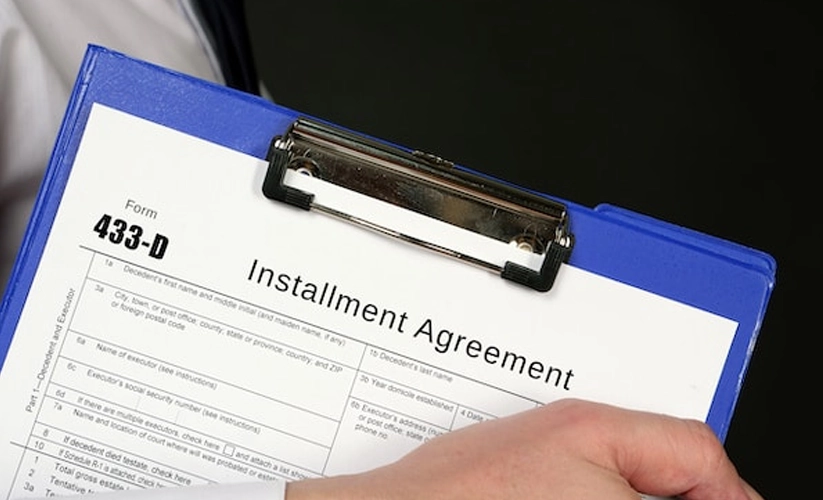Completing IRS Form 433D for Your Direct Debit Installment Agreement
Published:
A form for direct debit. Does the IRS have a form for taking Apple Pay?
If you are a self-employed individual or a business owner looking to set up a direct debit installment agreement with the Internal Revenue Service, you need to complete IRS Form 433D to set up your payment plan.
This tax form allows you to provide the necessary financial and personal information to the IRS to set up your direct debit payments.
To accurately complete Form 433D, follow these steps:
- Start by filling out your personal information, including your name, social security number, and taxpayer status.
- Provide your financial information, such as your monthly income and expenses. This will help the IRS assess your ability to make monthly payments.
- Indicate the type of payment plan you are requesting, including the amount you can afford to pay each month and the initial payment you are proposing.
- If you are a sole proprietor or self-employed, you will need to include additional information about your business income and expenses.
- Sign and date the form to certify the accuracy of the information provided.
Remember to include all the required sections and details in your Form 433-D Installment Agreement to avoid delays in processing your request.
For a detailed step by step walkthrough of completing the form correctly, watch this how-to video on how to complete this IRS Form 433D Video.
Which Installment Agreements with the IRS Use Form 433D?
This tax form is typically utilized by self-employed individuals, business owners, out-of-business sole proprietors, and individual taxpayers who are seeking a payment plan with the IRS and using
Form 433-D is necessary in situations where taxpayers owe delinquent employment taxes, personal or business income taxes, or the trust fund recovery penalty. Additionally, if you are a sole proprietor or self-employed and have outstanding federal taxes, you may be required to complete Form 433-D.
To determine eligibility for using Form 433-D, self-employed individuals, business owners, and individual taxpayers must assess their financial situation and ability to make monthly payments. This includes considering factors such as income, expenses, and the amount that can be afforded for monthly payments. Additionally, an initial payment proposal needs to be included.
By providing accurate and complete financial and personal information through Form 433-D, taxpayers can streamline the installment agreement process and increase their chances of approval. Remember, seeking guidance from a tax professional can help ensure that you navigate the form correctly and optimize your chances of obtaining an installment agreement. The 433-D form is the go-to for setting up a direct payment payment arrangement with the IRS. If you ever share the form, be sure to blackout confidential details, including your social security number.
What are the Terms and Conditions on a 433D?
This form, also known as the Installment Agreement Request, is used to request a direct debit agreement for their monthly payment plan to pay down any tax liabilities.
What Are the Agreements and Liabilities in 433D?
By completing Form 433-D, taxpayers agree to the terms of the installment agreement, which includes specific obligations and responsibilities. This form provides detailed financial information, such as employment income, expenses, and assets, to help the IRS determine the appropriate monthly payment terms.
Once the installment agreement is in place, individuals are responsible for making monthly payments on time. Failure to adhere to the payment schedule can result in consequences, such as additional penalties and interest charges. Moreover, missed payments may lead to the IRS taking collection actions, such as filing a tax lien on your property or garnishing your wages. On top of that, it’s crucial for taxpayers on a current installment agreement to always file their federal income tax returns on time and pay any new debts in full.
What If You’re Going to Miss a Payment?
If you anticipate missing a payment, it is important to take proactive steps to address the situation promptly. The first thing you should do is contact the Internal Revenue Service (IRS) as soon as possible. It is essential to communicate with them and explain the reason for the missed payment. This shows your willingness to resolve the issue and demonstrates that you are taking the situation seriously.
During your conversation with the IRS, discuss possible alternative plans that may be available to you. They may be able to offer options such as temporarily suspending your monthly payments, modifying your installment agreement, or adjusting the payment amounts. Exploring these alternatives can help prevent further penalties and consequences. You may also need to pay a one-time reinstatement fee if your payments were paused and need to restart.
Remember, open and honest communication with the IRS is key. By addressing the missed payment proactively and working with them to find a solution, you can minimize the impact on your financial situation.
You Must File All Future Tax Returns (But You May Not Get Your Refunds)
When you have an IRS installment agreement, you must file all future tax returns. While being on a payment plan is a helpful solution for managing your tax debt, it doesn’t exempt you from fulfilling your tax obligations.
During the period of your IRS installment agreement, it’s crucial that you continue to file your tax returns timely and accurately. Not only does this demonstrate your commitment to meeting your tax responsibilities, but it also helps the IRS stay updated on your financial situation.
It’s important to note that if you are entitled to receive a tax refund while under an installment agreement, the IRS may apply it to your outstanding tax debt. While this means you won’t receive the refund directly, it will reduce the amount you owe.
Remember, the goal of an installment agreement is to help you gradually pay off your federal income tax debt. By fulfilling your tax obligations and making your agreement payments, you are taking proactive steps towards resolving your tax situation.
The IRS Charges Service Fees for Installment Agreements
It’s important to be aware of these fees so that you can plan your finances accordingly.
The IRS does charge service fees for installment agreements, and there are three main types of fees that you should be aware of. First, there is a setup fee, which is the fee for establishing the installment agreement.
- $31 for online agreement plus direct debit
- $130 for agreement not completed online with direct debit
If you’re applying for an installment agreement without direct debit payments, you’ll have higher fees.
- $149 for online agreement
- $225 for no online agreement
Next, there is a reinstatement fee. This fee is charged if your installment agreement is terminated and you want to reinstate it. The reinstatement fee is $89.
Finally, there is a user fee, which is an ongoing fee that is charged annually for the privilege of participating in the installment agreement program. It’s important to note that these fees can change over time, so it’s always a good idea to check with the IRS for the most up-to-date information.
How Are IRS Form 433-D and Form 9465 Different?
While both forms are related to installment agreements for taxpayers, they serve slightly different purposes and have unique features and requirements.
IRS Form 433-D is specifically designed for individuals who owe taxes and need to set up a monthly payment plan. It provides detailed financial information about your income, expenses, assets, and liabilities. This form is commonly used by self-employed individuals and business owners who need to make regular payments towards their tax debt.
On the other hand, Form 9465 is the Installment Agreement Request form. It is used by both individual taxpayers and businesses to request a monthly payment plan to pay off their tax debt over time. Form 9465 does not require as much detailed financial information as Form 433-D. It generally includes basic taxpayer information, the type of tax owed, and the requested monthly payment amount.
While both forms serve the purpose of setting up a payment plan, Form 433-D is more comprehensive and requires a more detailed financial analysis. It is commonly used by individuals with complex financial situations or higher tax debts. In contrast, Form 9465 is a simpler and more straightforward form used by taxpayers with a lower tax liability.
What Are All of the Other 433 Forms?
One commonly used form is Form 433-A, which is the Collection Information Statement for Wage Earners and Self-Employed Individuals. It is used to gather financial information from individuals who are employed or self-employed. This form helps the IRS determine a taxpayer’s ability to pay their tax debt.
Another form, Form 433-A (OIC), is specifically used for taxpayers who are seeking an Offer in Compromise (OIC) to settle their tax debt. This form provides a detailed financial information statement to the IRS to evaluate whether the taxpayer qualifies for a reduced settlement amount. Form 433-F is a shorter, simpler version of 433-A, more of a generalized tax collection information statement.
For businesses, Form 433-B, the Collection Information Statement for Businesses Sole Proprietorships, is used to assess the financial situation of business owners. This form gathers information about the business’s income, assets, and expenses to determine the ability to pay outstanding tax liabilities.
These are just a few examples of the various forms used by the IRS in the Collection Information Statement process. It is essential to consult with a tax professional to ensure accurate completion of these forms and to understand the implications of the information provided.
Sources
“IRS Form 433-D walkthrough (Setting up an Installment Agreement)” – Teach Me! Personal Finance



